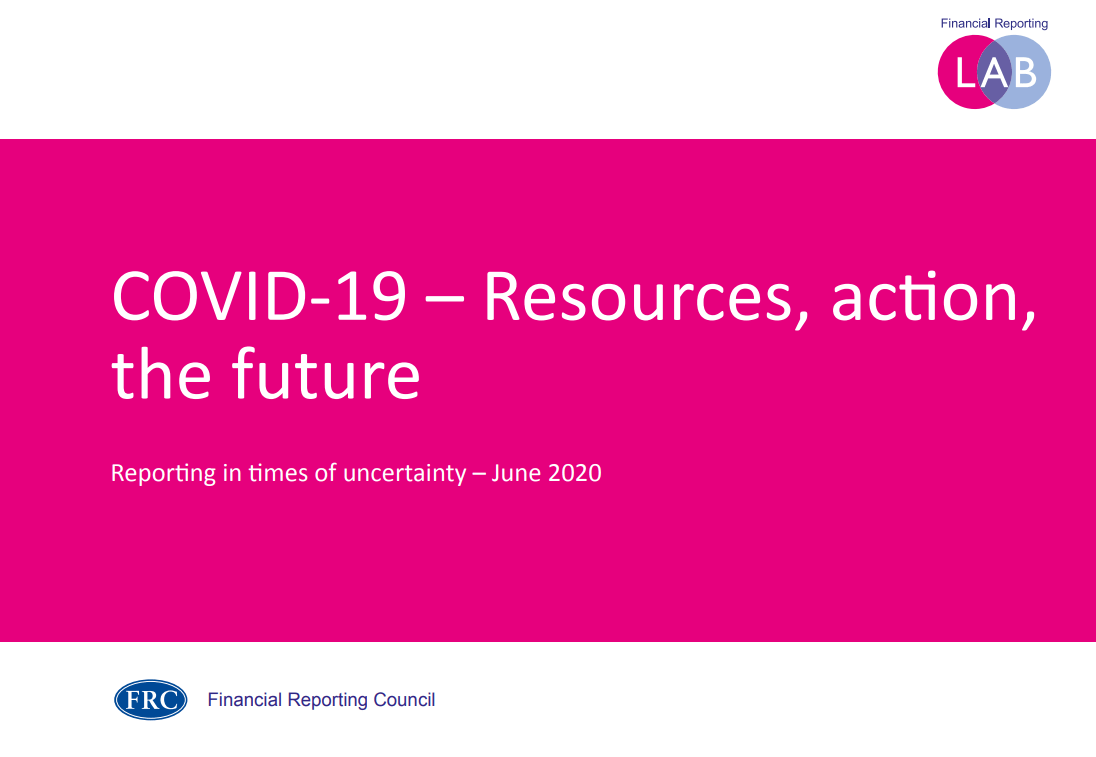
by John McCarthy Consulting Ltd. | Jun 15, 2020 | Blog
In May 2020, the EU Commission predicted that Irish GDP will contract by 7.9% in 2020, as a result of the Coronavirus (COVID-19). The good news is that it has predicted a bounce back of 6.1% in 2021.
In this climate, the provision of accurate financial information will be critical in getting Ireland back to health. Where can we find good, up to the minute guidance on this topic?
The hidden jewel in the crown of the Financial Reporting Council, the Financial Reporting Lab, has, once again, justified this title. On 15 June 2020, the Lab published two documents that give clear incisive guidance, with real life examples, dealing with:
- ‘Resources, actions and the future’ – practical advice to companies setting out the disclosures investors expect to see from companies during this time of uncertainty
- ‘Going concern, risk and viability’ – which gives guidance on going concern, risk and viability disclosures.
This week we focus on the Resources, actions and the future document that helps Directors and others with how to address three key topics in their annual reports:
- Resources – including the availability of cash.
- Actions – to manage short-term expenditure and ensure viability.
- The future – how the decisions taken now ensure the sustainability of the company and impact customers, suppliers and employees.
Covid-19 disclosures
If you would like to more examples of recent Coronavirus (COVID-19) disclosures in financial statements, see our recently published survey of 22 public company financial statements which highlight Coronavirus (COVID-19) disclosures.
The types of disclosures addressed in our report include topics such as:
- Emphasis of Matter
- Key Audit Matters in Audit Reports
- Going Concern/Viability
- Post Balance Sheet Events/Subsequent Events
This thirty-page report, is available on our website, and includes extracts from the types of disclosures that are prevalent at the moment. All this research, saving you time, is available to purchase for just €125+VAT, for immediate download.
For more on the Coronavirus (COVID-19) disclosures, please see our published report on our website here.
In our Publications Store, you will also find many complementary letters of representation templates that deal with the Coronavirus (COVID-19).

by John McCarthy Consulting Ltd. | Oct 21, 2016 | News
In this article, we consider practical tips for applying the requirements of Section 35 of FRS 102.
The Financial Reporting Council issued a report called the Annual Review of Corporate Reporting 2015/2016 on 21 October 2016 encouraging smaller entities to ‘start their planning as soon as possible in order to ensure they are prepared for a smooth transition’.
In this report, the FRC stated that ‘small entities will also be applying FRS102 for the first time from 1 January 2016, which may pose some challenges for preparers, but should improve reporting in certain areas, as well as offering opportunities to reconsider the necessary disclosures. Anecdotal evidence suggests that some of the larger private companies applying FRS 102 from 1 January 2015 could have started their planning for transition earlier; any entities yet to transition to new standards should start their planning as soon as possible to ensure they are prepared for a smooth transition.’
This article assumes that readers have used the FRSSE (2015) for the year ended 31 December 2015 and will now be adopting FRS 102 for the first time for year ended 31 December 2016.
Review of existing accounting policies
Companies will need to perform a detailed review of whether their current accounting policies meet the requirements of FRS 102 Financial Reporting Standard applicable in the Irish and Ireland, and whether change is necessary or desirable. and changes in accounting policy will be inevitable.
In some cases, the requirements under FRS 102 will be different from previous Irish GAAP However, transition to FRS 102 can also provide an opportunity to look again at current accounting policies and reconsider their appropriateness to the business. In some cases, there will also be accounting rules that were not previously in place e.g. the rule about recording transactions in the functional currency which can be in a currency other than the Euro, if the company’s sales are denominated mostly in sterling or dollars.
Time is of the essence
FRS 102 generally requires retrospective application (in our example the transition date will be 1 January 2015 and therefore the comparatives for the year ended 31 December 2015 will need revised under the new rules). It is very important to identify those areas most likely to have a significant impact on the financial statements and actions which might be taken to ease the burden, for example deciding which of the eighteen exemptions (currently available) to take.
You need to identify those actions which are time-critical, that is areas where action (or inaction) at transition will have a direct impact on the accounting treatment and the options available. Special care will need to be taken by entities that have hedging arrangements or defined benefit pension schemes.
Gathering information for restatement of comparatives
Don’t underestimate the challenge of restating comparative information, including numerical and narrative disclosures, on first-time adoption of FRS 102. There may be disclosures which were not required previously (e.g. the statement of cash flows) or which are now required in greater depth e.g. changes to the accounting policies on turnover and stock. It is hoped that the new companies Act (when enacted) will update the Companies Ct, 2014 and will allow smaller companies avail of the exemption form the statement of cash flows.
This information will generally be easier to gather at the time a transaction takes place or close the date a balance arises, rather than when the first FRS 102 financial statements are being prepared.







